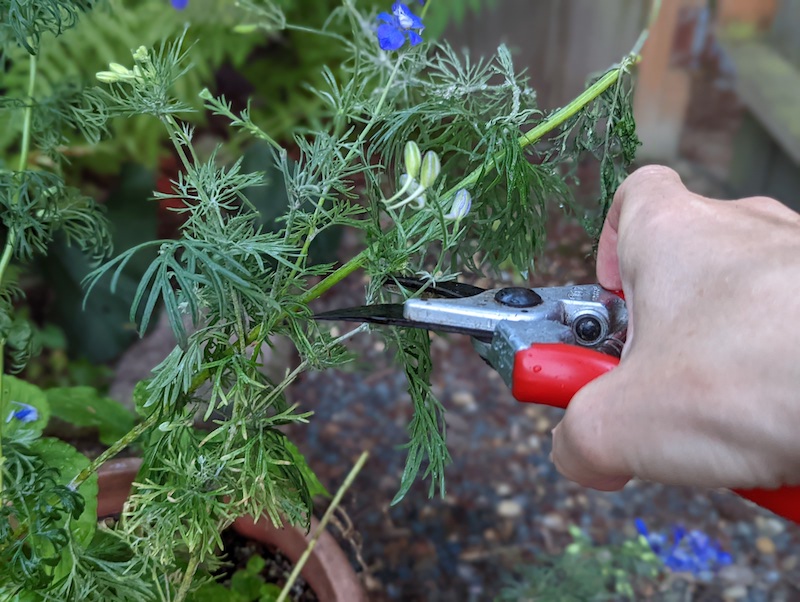Larkspur is an ornamental perennial that does need regular pruning during the growing season. The pruning consists of deadheading spent blooms to encourage the plant to produce more blooms. Since Larkspur dies back to the ground every winter, there is no other maintenance pruning needed other than cutting the old plant material off at the base of the plant. Removing the spent plant material is basic garden hygiene that helps to keep diseases or pests from overwintering in the garden.

When to Prune Larkspur
Deadheading Larkspur should happen throughout the growing season. As the flower spikes fade, cut the stems all the way back to a set of leaves or a visible growth bud. This will help to encourage new flowers and keep the plant compact and tidy.
Seasonal cleanup of the whole plant can happen during the fall or late winter. Cut back all of the dead or dying top growth to within 1-2 inches from the soil level. Be careful to not damage the growth crown by cutting too far down to the ground. Mulch the plant with a thick layer of organic material to insulate it for the winter. Cutting back spent top growth in the spring makes way for vigorous new growth.
As the new sprouts emerge, carefully cut out all of the dead stems and leaves. If there were no diseases on the plant, this spent material can be composted. Any diseased material needs to be thrown in the trash or burned. Backyard composting rarely gets hot enough to kill off pathogens.

Why Prune Larkspur
Larkspur needs two types of pruning: deadheading and end-of-the-season cutting back. Deadheading will encourage more and longer blooming while also keeping the plant's compact appearance. Cutting back the dead top growth helps to control diseases and pests in the garden and make way for the new season's growth.
How to Prune Larkspur
Step 1 - Deadheading to prolong blooming
As flowers fade, they need to be cut back before they start to ripen seed. Cut the flower stem all the way back to the main stem or a visible set of buds. This keeps the plant tidy and compact with no naked stems showing.
Step 2 - Fall clean-up
Cut the dying or dead top growth back to within 1-2 inches of the soil. When this is done in the fall, mulch the growth crown thickly with shredded leaves, compost, or arborist chips for added insulation.
Step 3 - End of winter clean-up
Cut back all dead plant material to the basal growth. Be careful to not disturb the crown or roots. This is also time for the first fertilizing of the growing season.
Larkspur Pruning Tips
- Deadhead regularly to encourage new flower growth
- Cut flower stems back to the main stem to help keep the plant compact and avoid naked stems
- Add a layer of mulch to protect the growth crown after cutting back dead top growth in the fall
- Leaving 1-2 inches of stem above ground helps to mark the plant’s location to avoid accidental damage during the winter and spring.
 |
Author Robbin Small - Published 8-22-2022 |
